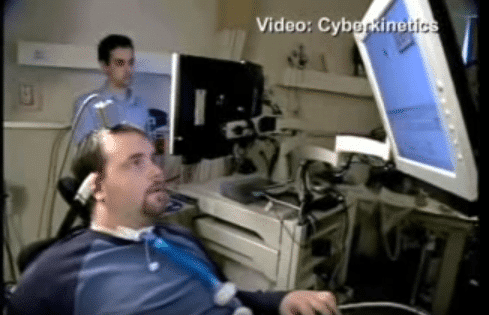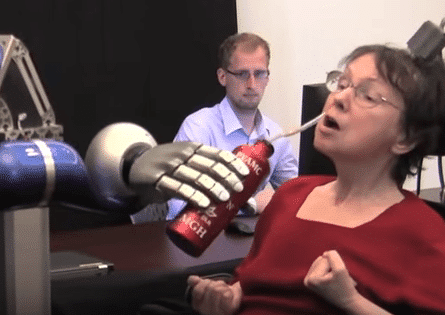Controlling your feelings, adding or removing memories at will, and controlling our devices telepathically… is this purely the world of science fiction? Evidently not:
Sure, the bulldozer might have been created just to push soil and gravel off of a construction site, but that doesn’t mean that it can’t be fitted with slightly different equipment to dig ditches, or create giant mounds and hills.
Sure, the airplane might have been created with the eventual dream of commercial flight and transportation, but it didn’t take more than a dozen years from the Wright brothers’ first flight to the first fighter planes in the skies above Europe in World War I.
Neurotechnology – I predict – will also enjoy a kind of flourishing use well outside it’s original purpose. From memory enhancement, to feeling happier, to adding entirely new senses, there are mammals and humans undergoing procedures that – in the future – might not just help to ameliorate disease, but might redefine “normal cognitive function” by enhancing our minds.
Brain-machine interface technologies have made tremendous leaps forward in the last 20 years, but many of the fruits of the field remain exclusively in research labs, some receiving little or no media attention whatsoever.
On the Emerj podcast we’ve been lucky enough to interview many renown neuroscientists and brain-machine interface specialists, and through those conversations and my own homework, I’ve assembled a
Why not start out with telepathic control of technology?
At BrainGate, a brain-machine interface laboratory originally started at Brown University, telepathic control of technology is old hat. Here’s a 2008 image of Matthew Nagel (a BrainGate patient) moving and clicking a computer cursor with dexterity, all with mind control, using a chip embedded into his motor cortex:

Below is a 2012 image of another BrainGate patient, Cathy, controlling a multi-jointed robotic arm to pick up a cup of iced coffee with a straw in it, bring it to her mouth, and sip. This simple action had been impossible for Cathy since her stroke in 1998:

(Cathy’s amazing brain-machine interface dexterity can be seen in this video by the journal Nature)
Brain-machine interfaces are in no way limited to telepathic control of technology. In fact, patients with extreme cases of long-standing depression are eligible to undergo “deep brain stimulation” (DBS) in order to manually stimulate brain centers (usually what is called “area 25”) where neuroscientists have reason to believe mood may be effected.
Below is an representative image of the two DBS electrodes that are drilled in through the skull in order to deliver the manual stimulation:

Much like a pacemaker, a DBS includes an implanted battery that is tucked under he collarbone. This procedure has had a better-than-50% success rate at improving mood and perceived well-being in patients with extreme, pervasive depression, and ongoing research is still underway to use similar treatments for obsessive-compulsive disorder, obesity, and more.
Great, we’ll be “fixing” people with serious conditions to gain feeling and functionality again. Sure that’s exciting, but it doesn’t look much like “enhancement.” At least not yet.
But as the plane, the bulldozer, and most any other technological advancement have taught us… technology doesn’t like to stay in one sandbox. If paralyzed folks are able to respond to email and control technology around them with their thoughts alone, how long will it be until some financial trading company “hooks up” some of their quantitative traders to manage more trading and pattern recognition, or some military “hooks up” their pilots in order to control more features of increasingly complex aircraft?
When deep brain stimulation becomes a commonplace and safe treatment for depression, how long will it be until psychologically “normal” people want to control their emotions in order to overcome a recent breakup or divorce, stay calm at work, or simply enhance their day-to-day happiness to a new definition of normal?
“But surely,” someone will say, “no one without severe depression would ever spend the money and potentially risk their health in order to simply feel an everyday ‘8’ on a happiness scale of 1-10, as opposed to an everyday ‘5’.” There is evidence to believe that this notion is false.
Below, you’ll see a chart from Drugs.com featuring the highest grossing pharmaceutical products in the USA across 2013 and Q1 of 2014. Number one is Abilify, an anti-depressant… and it’s far from being the only mood-altering pill to make it into the top ten in the last 20 years:

It seems safe to say that if there is anything in the world that warrants a rabid consumer market, it is feelings and emotions themselves. For better or for worse, I predict that as soon as relatively safe and reliable mood-enhancing procedures are available on the market, there will be a huge push to bring their benefits to the psychologically “normal” who just want an emotional boost.
In the CNN interview from which our previous deep brain stimulation screen shot was taken, the interviewed, Dr Sanjay Gupta asked the DBS patient:
“How did it feel to know a machine and electricity could change your emotions like that?”
Smiling buoyantly, the patient replied:
“It felt fantastic, I didn’t care what was doing it… it just… felt… great.”
She hadn’t felt joy in what seemed like an eternity, “I felt feelings that I thought were long gone.”
And… I think that’s part of the point. Not only will these neurotechnologies allow us to help people who are below normal human function… but they might also open up new possibilities that “psychologically normal” people will not only crave, but maybe… deserve to have access to.
With respect to happiness, we may be able to do more than “keep people normal” or “make people a little happier”… we may be able to stimulate the brain in novel ways to create new, rich, unique emotional experiences that humans are presently not privy to.
Similarly, with respect to telepathic technology control, inevitable progress may take us beyond “recovering normal motor function”… and may open up a gateway into a more expansive, creative use of mental activity, controlling extra limbs and myriad computer programs with the same intuitive dexterity with which we control our own hands and fingers.
Who is to say that brain-to-brain communication, memory enhancement, or any other such neurotechnology would not be subject to those same base human drives fore more, for further?
As technologies intended to fix the mind begin to allow for it’s enhancement, who’s to say where we should or should not tread?




















